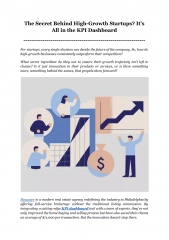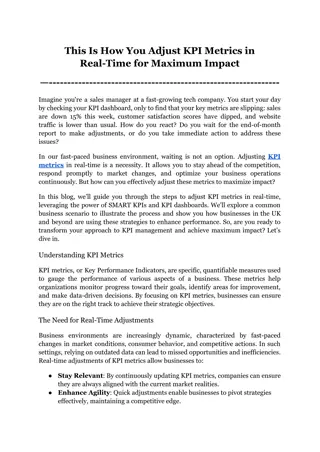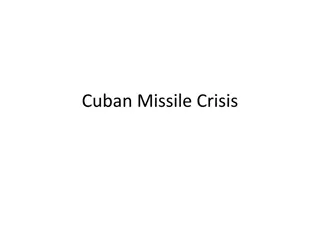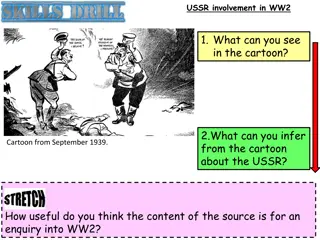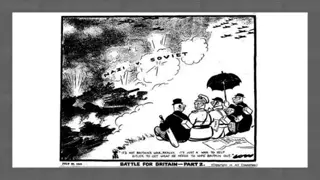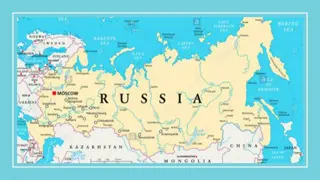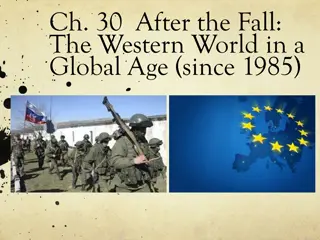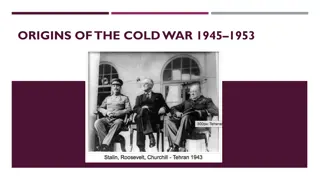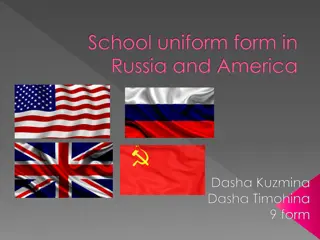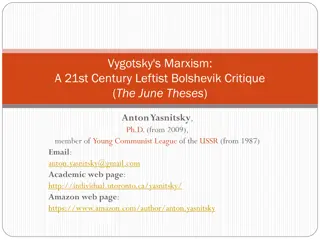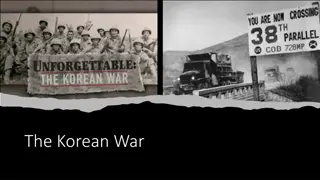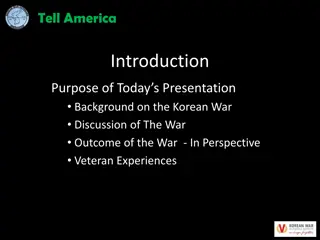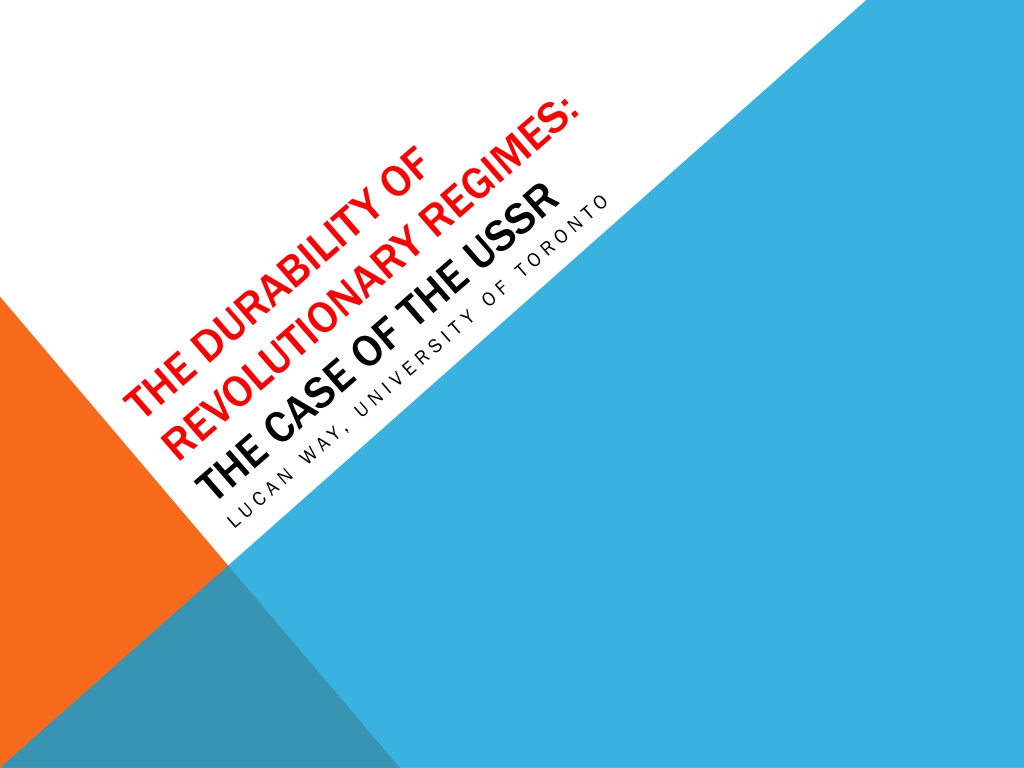
Understanding Authoritarian Durability in Revolutionary Regimes
Explore the factors contributing to the enduring nature of revolutionary authoritarian regimes in the modern era, with insights into their prolonged tenure, resilience in times of severe crises, emergence dynamics, and theories of durability. Delve into the cohesive party structures and ideologies that sustain these regimes against internal and external pressures.
Download Presentation

Please find below an Image/Link to download the presentation.
The content on the website is provided AS IS for your information and personal use only. It may not be sold, licensed, or shared on other websites without obtaining consent from the author. Download presentation by click this link. If you encounter any issues during the download, it is possible that the publisher has removed the file from their server.
E N D
Presentation Transcript
WHAT EXPLAINS AUTHORITARIAN DURABILITY? Revolutionary Regimes among the most durable Revolutionary Regimes among the most durable forms of authoritarianism in the modern era forms of authoritarianism in the modern era Average tenure of Revolutionary Regimes Average tenure of Revolutionary Regimes since 1900: since 1900: 31 years 31 years Average tenure of Average tenure of non non- -Revolutionary since since 1900: 1900: 16 years 16 years Revolutionary Regimes Regimes
REVOLUTIONARY DURABILITY IN THE FACE OF SEVERE CRISIS Large scale famine Large scale famine (USSR, China, N Korea) (USSR, China, N Korea) Severe Severe e economic downturn conomic downturn (Zimbabwe in the 2000s. Cuba in the 1990s) 2000s. Cuba in the 1990s) (Zimbabwe in the Severe external pressure Severe external pressure (Russia after 1917; Cuba, Iran, Vietnam) Cuba, Iran, Vietnam) (Russia after 1917;
REVOLUTIONARY REGIME REVOLUTIONARY REGIME Authoritarian regimes that emerge Authoritarian regimes that emerge out of sustained, sustained, ideological ideological, and struggle from below struggle from below, and whose establishment is accompanied by establishment is accompanied by mass mobilization mobilization and significant efforts to and significant efforts to transform state structures transform state structures and the existing social order existing social order. . out of , and violent violent , and whose mass and the
REVOLUTIONARY REGIMES SINCE 1900 REVOLUTIONARY REGIMES SINCE 1900
REVOLUTIONARY REGIMES C Classic lassic S Social China, Cuba, Iran, Mexico, Russia ocial R Revolutions: evolutions: Radical Radical national liberation national liberation struggles: Angola, Mozambique, Vietnam, Zimbabwe struggles:
COHESIVE PARTY COHESIVE PARTY Blood + Ideas = Unity Blood + Ideas = Unity A Armed struggle creates rmed struggle creates military ethos Ideological Polarization Ideological Polarization creates us and them ethos them ethos Defection = treason Fear of counter-revolution military ethos creates us and
STRONG AND LOYAL OF ARMY STRONG AND LOYAL OF ARMY Coups greatest threat to authoritarian Coups greatest threat to authoritarian regimes regimes Creation of new armed services Creation of new armed services from scratch scratch ties security services to ruling ties security services to ruling party party fewer coups fewer coups from
DESTRUCTION OF ALTERNATIVES DESTRUCTION OF ALTERNATIVES Not just institutions but societal context Not just institutions but societal context War facilitates destruction of alternative War facilitates destruction of alternative power centers: power centers: old army, church, other parties Increased room for error Increased room for error
THE USSR: A DURABLE AUTHORITARIAN REGIME 74 years 74 years Multiple and severe crises: Multiple and severe crises: Early death of founding leader (1922-24) Famines 1921, 1932-3 War with Germany Cold War
USSR AND THE COMMUNIST PARTY-STATE Invention of the authoritarian party state: Invention of the authoritarian party state: Samuel Huntington: Samuel Huntington: CPSU the CPSU the ultimate organizational weapon and ultimate organizational weapon and the chief Bolshevik contribution to modern the chief Bolshevik contribution to modern politics politics. .
LENIN AND SOVIET DURABILITY What is to be Done? What is to be Done? (1902) Revolution to be created Revolution to be created by small, disciplined, by small, disciplined, vanguard party vanguard party (1902)
BUT: BOLSHEVIKS NOT LENINIST BEFORE 1917 Party racked by Party racked by indiscipline before 1917 indiscipline before 1917 Focus on Focus on intellectual intellectual debate debate Obedience to Lenin Obedience to Lenin the exception rather than the exception rather than the rule rule Local autonomy of party Local autonomy of party cells cells the
MY THEORY: MY THEORY: ORIGINS OF SOVIET DURABILITY ORIGINS OF SOVIET DURABILITY Bolshevik Bolshevik radicalism radicalism polarization war war polarization and civil and civil Extremely Disciplined Party Extremely Disciplined Party Powerful and Loyal Security Services Powerful and Loyal Security Services Destruction of alternative centers of power Destruction of alternative centers of power
BOLSHEVIK RADICALISM Break with Mensheviks in 1903 Break with Mensheviks in 1903 Immediate seizure of power Immediate seizure of power by Socialist Parties Parties Nationalization of land, Nationalization of land, end of private property property Acceptance/Embrace of Acceptance/Embrace of Red Terror by Socialist end of private Red Terror
BOLSHEVIK RADICALISM AND CIVIL WAR October Revolution creates challenge October Revolution creates challenge to domestic domestic and and world world capitalist order Domestic Domestic: Old army/bureaucracy, land : Old army/bureaucracy, land owning class owning class International International: Russia : Russia a Socialist oasis the middle of the raging imperialist sea. the middle of the raging imperialist sea. to capitalist order a Socialist oasis on on
CIVIL WAR AND PARTY DISCIPLINE Civil war Civil war formative formative education almost all top leaders until the 1950s active in civil war almost all top leaders until the 1950s active in civil war (1) (1) life and death struggle life and death struggle convinces local convinces local party officials to to seek seek greater subordination to the center; greater subordination to the center; (2 (2) ) the infusion of the infusion of new tougher cadres new tougher cadres: leather jacketed thugs thugs education for the party leadership; for the party leadership; party officials : leather jacketed
CIVIL WAR AND THE SECURITY SERVICES Initially Initially standing army not envisioned in Socialist standing army not envisioned in Socialist state state Cheka (KGB) a product of hasty innovation Brutality of civil war + Marxist class war Normalization of extreme brutality Cheka fused with party Lenin: Lenin: A good Communist is also a good A good Communist is also a good Chekist Cheka Cheka high high esprit de esprit de corp corp Chekist
CIVIL WAR AND DESTRUCTION OF ALTERNATIVES Old Army Old Army After war: coopted, dead or in exile Monarchy/landowners Monarchy/landowners Other Other sociailst sociailst parties parties (SRs, Mensheviks) Motivates destruction of SRs, Mensheviks Motivates destruction of SRs, Mensheviks Polarization Polarization self limiting of Menshevik/SR opposition
POSTWAR SOVIET STATE Miraculous victory Miraculous victory Small party in 1917 world s first Socialist state Isolated Internationally Isolated Internationally International pariah War scare Isolated from rest of population Isolated from rest of population Kronstadt rebellion 1921
USSR AFTER THE CIVIL WAR USSR AFTER THE CIVIL WAR Limited Limited economic economic transformation transformation No Central Planning No Central Planning real social revolution 1929? real social revolution 1929?
CORE ELEMENTS OF SOVIET SYSTEM THE PARTY THE PARTY Quasi-religious conception of party discipline ban on factions 1921 First mover advantage and succession struggle Leather jacketed thugs
CORE ELEMENTS OF SOVIET SYSTEM THE KGB THE KGB Effective Effective: : Cheka Brutal Brutal: names of : names of Cheka power the same power the same Stomach for violence against political enemies Loyal Loyal: strong ties to party : strong ties to party No coup attempt until 1991 Cheka a a vast and effective apparatus vast and effective apparatus Cheka change but prerogatives and change but prerogatives and
CORE ELEMENTS OF SOVIET SYSTEM NO RIVALS NO RIVALS No serious organized opposition No serious organized opposition Anti Soviet forces Anti Soviet forces exhausted and prostrate or exhausted and prostrate or pulverized pulverized Room for error by regime Room for error by regime
DURABILITY IN FACE OF CRISIS DURABILITY IN FACE OF CRISIS Party discipline and succession crisis 1922 Party discipline and succession crisis 1922- - 1924 1924 Trotsky: My party right or wrong .. I know one cannot be right against the party ... for history has not created other ways for the realization of what is right Others support Stalin for fear of counter-revolution Famine 1921, 1932 Famine 1921, 1932- -33 33 WWII WWII
CONCLUSION Not leadership Not leadership Ideas and Violence Ideas and Violence and durability and durability


